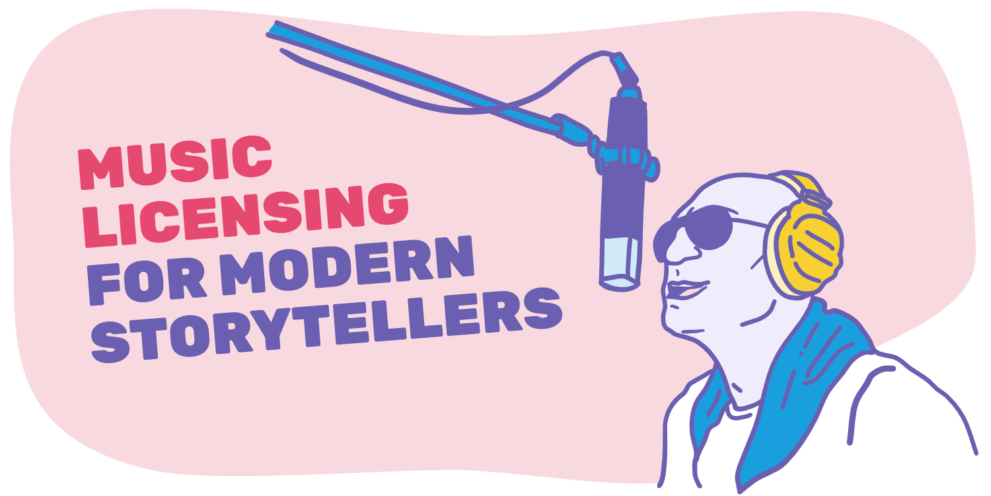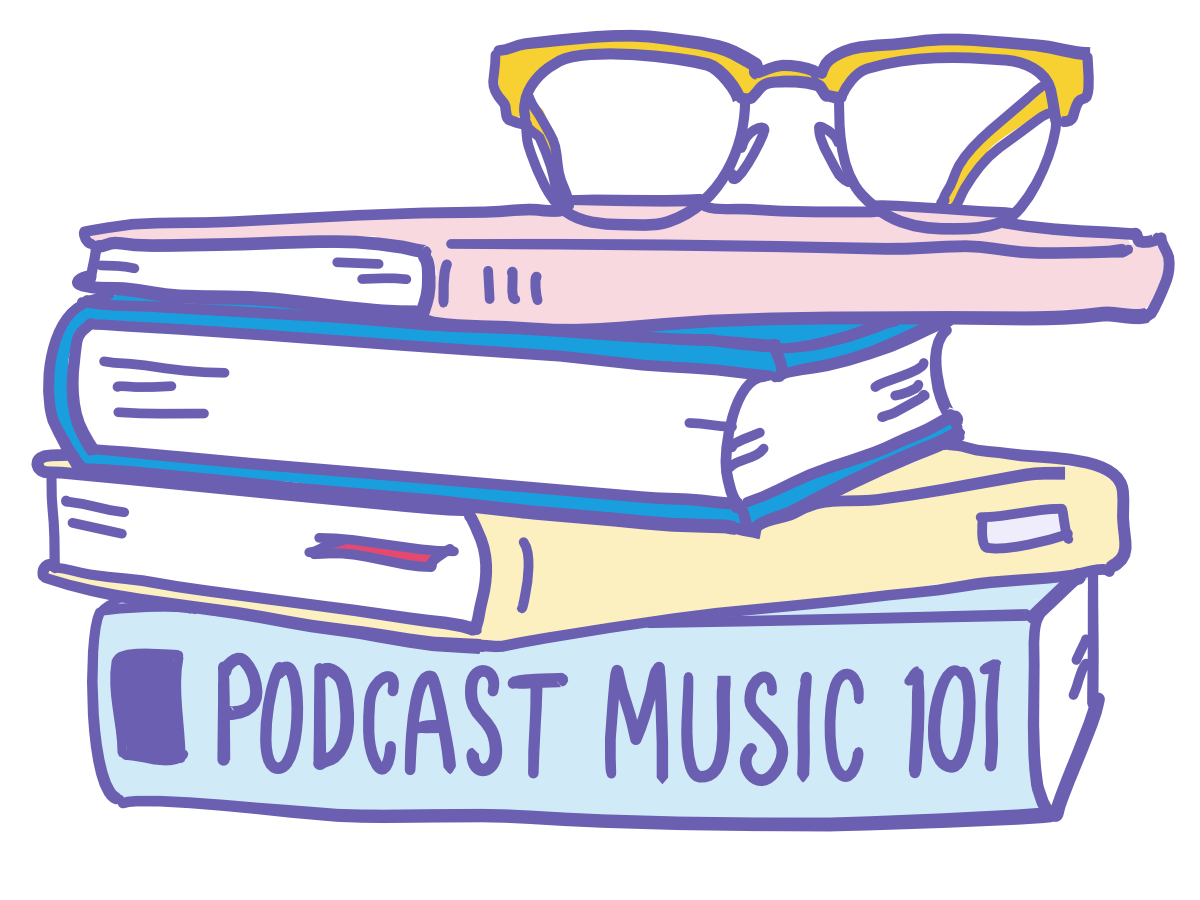Music for Podcasts: Where to Download, How to Use, and More

The right music can give your show a stronger identity and a more professional sound. Discover how to legally download and use music for podcasts in this guide.
October 3, 2014, marked the launch of Serial, an investigative journalism podcast.
Now quite famous, the show broke download and streaming records and, I’d argue, finally pushed podcasting into the mainstream.
I still remember the way it dominated water cooler chat at the office. And after listening to the first episode, I immediately understood why.
The story itself was fascinating, sure. But the production style was unlike that of any podcast I’d listened to up to that point.
Specifically, the way Serial used music in the podcast added a richness and depth that the narrative wouldn’t have had otherwise.
And today, hundreds (if not thousands) of other podcasts mimic that style with the goal of gripping listeners as Serial did.
If you’re eager to do the same, read on to learn where to find the best music for your podcast, as well as how to use it effectively.

Free podcasting music
Later in this article, we’ll explore important topics, such as how to use music for podcasts legally and strategically. But I’m guessing you’re most interested to know where you can find the music in the first place.
So, why not have a little dessert before dinner? Browse the Music for Makers library of songs to find the right track for your podcast.

Music for podcasts: What’s legal?
One of the best things about the internet is that incredible music is merely a click away. But, dear podcaster, most of that music comes with strings attached.
If you get your podcast music from the sources above, you’ll be fine. But if you want to use a song from somewhere else, you should know a few things first.
I’ve written before about the complexities of using copyrighted music in videos. And the world of podcasting isn’t too much different.
But, just to be thorough, let’s quickly cover what constitutes “podsafe music,” or music that you can legally use in your podcast.
Disclaimer: Though I run a music licensing website and am quite cozy with copyright laws, I’m not an attorney. For any questions or concerns, I recommend consulting a legal professional.
How to tell if music is copyrighted
In the U.S., original music is considered copyrighted the second it’s created. So, in a sense, all music is protected by copyright. The one exception is music that has entered the Public Domain (also known as Creative Commons Zero).
Copyright owners may dedicate their works to the Public Domain. But generally, music in the Public Domain is simply so old that its copyright has expired. As of 2019, that includes stuff created before 1924. So, for the vast majority of podcasts, Public Domain music isn’t all that useful.
To use copyrighted music in your podcast, you need a license from the copyright holder of the composition (often an artist or publishing company), as well as one from the copyright holder of the recorded performance (usually a record label).
This is why using popular music in your podcast can be quite tricky. Want to kick off your show with Beyoncé’s latest song? Good luck getting in touch with Columbia Records and Queen B herself. (And let’s not even talk about how much that would cost…)
Does podcast music have to be royalty-free?
When it comes to music for podcasts, copyright is just one piece of the puzzle. Even if a copyright holder allows you to use a song, you could find yourself owing money in the form of royalties down the road.
Royalties are dues that copyright holders receive every time someone streams or performs their music.
When you play a track on Spotify, for example, the copyright owner gets paid a tiny fraction of a cent.
This is another reason why licensing music from a royalty-free library is your best option. Doing so ensures that you only pay for a song once (rather than each time a listener downloads or streams your podcast).
By the way, “free” doesn’t mean “royalty-free.” This is a common misconception. Even if a copyright holder gives a song away, it may still be protected by a performance rights organization — such as ASCAP, BMI, or SESAC — and, therefore, require royalties.
Does podcast music require attribution?
Once you have a license from the copyright holder and you’ve made sure the music is royalty-free, the final detail to confirm is whether you have to give credit to the music source.
You’ve probably heard podcast hosts do this before. Many mention the artist(s) at the end of the show and may also link to them in the show notes. Podcasters sometimes do this simply to show appreciation and support. Other times, however, it’s legally required. It all comes down to the license.
A good rule of thumb is, ‘If you don’t pay for it, you have to include attribution.’ But that’s not always the case.
For example, you don’t have to include attribution if you use my music. (But you’re welcome to!) On the other hand, some paid libraries require you to link back to them — even after you’ve purchased a license.
The moral of the story is to read the music license or just ask the copyright holder. For instance, several independent artists on SoundCloud will happily allow you to use their music for podcasts as long as you give them credit.

Podcasting music best practices
Let’s get something out of the way: You don’t have to add music to your podcast. Many people choose not to. And if you use a song poorly, it could make your podcast worse.
That might seem like an odd thing for me to say, given that I sell music to podcasters. But it’s true. To help you decide when and how to use music in your podcast, here are a few best practices to remember.
Theme music for podcasts
Your podcast already has a voice (yours). But a theme song — the most common application of music in podcasts — can help give it an identity.
Theme music serves as a sort of auditory logo. It’s part of your brand, something that distinguishes you from other podcasts and sets expectations for your listeners.
Are you the host of a spooky, true-crime podcast? You might want to use an eerie theme song. Or, if you’re more about helping your listeners become their best selves, inspirational music might be a better fit. It all comes down to how you want your audience to feel when listening.
Professional podcasters often use theme music to open (and sometimes close) their shows. But you can also weave theme music throughout an episode — especially longer ones — to tie segments together and maintain a consistent tone.
Intro and outro music for podcasts
As we just covered, you can use a dedicated theme song for the intro and outro of all your podcast episodes. But because intro music establishes the mood for the rest of the show, it may make sense to use a unique track each time.
Ultimately, you must decide what your goal is: to reinforce brand identity or to set the context of your story from the start. Your podcast topic may help dictate this, as well. An interview-centric show about marketing, for example, would likely benefit most from a consistent tune.
From a more technical standpoint, it’s generally wise to make your intro music brief. Justin Jackson, podcaster and founder of Transistor.fm, recommends aiming for five seconds. This ensures you jump into the meat of the episode right away and thus avoid annoying or boring listeners.
Outro music can be longer, as it typically serves as a backdrop to closing remarks.
Meet the hosting platform top podcasters trust.
Transistor offers premium podcast hosting, distribution, analytics, transcription, and so much more.
Try TransistorTransition music for podcasts (e.g., bumpers and stingers)
When a podcast host shifts to a new topic in a show, transition music signals to listeners that a change is coming. It’s comparable to a subhead or page break in an article and results in a smoother listening experience.
As with the other musical applications we’ve covered, transition music also allows you to influence the overall vibe of the following podcast segment. So, if you’re moving from a somber story to a happier one, an uplifting transition tune can help prevent emotional whiplash for your audience.
Pro Tip: Transition songs are sometimes called bumpers or stingers. These terms have become relatively interchangeable, but they do sometimes refer to length. Bumpers are usually no longer than 15 seconds, and stingers less than five.
Podcast music beds (i.e., background music)
The best background music for podcasts often goes unnoticed. It’s subtle enough to not be distracting. Yet it sends a powerful emotional cue to listeners, whether they’re aware of it or not.
Background music adds a thematic sparkle to an ordinarily mundane telling of an account. It transforms straightforward monologues into goosebump-giving narratives. It makes every aspect of a story more enticing and vivid.
Pro Tip: Selecting the right background music for podcasts can be challenging. For further reading, check out this guide on picking the best music bed for your project »
Keep in mind that music beds are most effective when they are instrumental and played at a lower level than voices. (This is true for all podcast music applications, not just background songs.)
Enrich your stories with podsafe music
Thanks for sticking with me! I hope this guide has helped clarify the sometimes confusing relationship between podcasting and music.
Adding music to your podcast can help you increase audience engagement, brand awareness, and your show’s overall level of professionalism. And with Music for Makers, sourcing great music for podcasts is simple and affordable.
But don’t take my word for it. Here’s what a Music for Makers fan (and Webby Awards nominee for best podcast series!) had to say:
I love having a library of interesting songs I can use in my podcast to help add a little dimension to the stories I’m telling. Music for Makers has such a vast library … there are so many songs that can be looped seamlessly and without much more work on my part, as an editor. — Emily Prokop, The Story Behind Podcast
Ready to enhance your podcast?
Browse Music Now